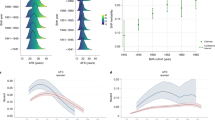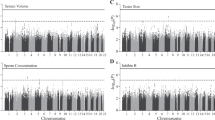Abstract
A number of theoretical approaches to understanding the etiology of ejaculatory dysfunction have been proposed, but no study has yet found conclusive evidence that premature (PE) or delayed (DE) ejaculation is under genetic control. We conducted twin model fitting analyses on different indicator variables of ejaculatory function on a population-based sample of 3946 twins and their siblings (age 18–48; mean=29.9 years) to investigate genetic, shared environmental and unique environmental effects on PE and DE. A significant moderate genetic effect (28%) was found for PE. No clear-cut familial effect could be detected for DE. Significant associations between ejaculatory function and age were detected, but effects of age were generally very weak. The findings from the present study provide useful information regarding the etiology and understanding of ejaculatory dysfunction.
This is a preview of subscription content, access via your institution
Access options
Subscribe to this journal
Receive 8 print issues and online access
$259.00 per year
only $32.38 per issue
Buy this article
- Purchase on Springer Link
- Instant access to full article PDF
Prices may be subject to local taxes which are calculated during checkout

Similar content being viewed by others
References
Jannini E, Lombardo F, Lenzi A . Correlation between ejaculatory and erectile dysfunction. Int J Androl 2005; 28: 40–46.
Waldinger M . Lifelong premature ejaculation: current debate on definition and treatment. J Men's Health Gend 2005; 2: 333–338.
Montorsi F . Prevalence of premature ejaculation: a global and regional perspective. J Sex Med 2005; 2: 96–102.
McMahon C . Premature ejaculation: past, present and future perspectives. J Sex Med 2005; 2 (Suppl 2): 94–95.
Althof S . The psychology of premature ejaculation: therapies and consequences. J Sex Med 2006; 3 (Suppl 4): 324–331.
Waldinger M . The neurobiological approach to premature ejaculation. J Urol 2002; 168: 2359–2367.
Donatucci C . Etiology of ejaculation and pathophysiology of premature ejaculation. J Sex Med 2006; 3 (Suppl 4): 303–308.
Corona G, Jannini E, Mannucci E, Fisher A, Lotti F, Petrone L et al. Different testosterone levels are associated with ejaculatory dysfunction. J Sex Med 2008; published article online April 10, 2008. DOI: 10.1111/j.1743-6109.2008.00846.x.
Waldinger M, Rietschel M, Nöthen M, Hengeveld M, Olivier B . Familial occurrence of primary premature ejaculation. Psychiatr Genet 1998; 8: 37–40.
Jern P, Santtila P, Witting K, Alanko K, Harlaar N, Johansson A et al. Premature and delayed ejaculation: genetic and environmental effects in a population-based sample of Finnish twins. J Sex Med 2007; 4: 1739–1749.
Waldinger M, Schweitzer D . The use of old and recent DSM definitions of premature ejaculation in observational studies: a contribution to the present debate for a new classification of PE in the DSM-V. J Sex Med 2008; 5: 1079–1087.
Rosen R . Prevalence and risk factors of sexual dysfunction in men and women. Curr Psychiatry Rep 2000; 2: 189–195.
Jannini E, Simonelli C, Lenzi A . A sexological approach to ejaculatory dysfunction. Int J Androl 2002; 25: 317–323.
Nathan S . The epidemiology of the DSM-III psychosexual dysfunctions. J Sex Marital Ther 1986; 12: 267–281.
Schapiro B . Premature ejaculation: a review of 1130 cases. J Urol 1943; 50: 37–40.
Kriegsfeld L, Demas G, Huang P, Burnet A, Nelson R . Ejaculatory abnormalities in mice lacking the gene for endothelial nitric oxide synthase (eNOS−/−)—a critical review of the empirical literature. Physiol Behav 1999; 67: 374–379.
Waldinger M, Quinn P, Dilleen M, Mundayat R, Schweitzer D, Boolell M . A multinational population survey of intravaginal ejaculation latency time. J Sex Med 2005; 2: 492.
Santtila P, Sandnabba NK, Jern P, Varjonen M, Witting K, von der Pahlen B . Recreational use of erectile dysfunction medication may decrease trust in ability to gain and hold erections in young males. Int J Impot Res 2007; 19: 591–596.
Grenier G, Byers S . The relationships among ejaculatory control, ejaculatory latency and attempts to prolong heterosexual intercourse. Arch Sex Behav 1997; 26: 27–47.
Tabachnich B, Fidell L . Using Multivariate Statistics, 4th edn. HarperCollins: New York, 2001.
Neale M, Boker S, Xie G, Maes H . Mx: Statistical Modeling 6th edn. Department of Psychiatry, 2002. Available at: http://www.vcu.edu/mx/. (accessed 18 March 2006).
Akaike H . Factor analysis and AIC. Psychometrika 1987; 52: 317–332.
Hong LK . Survival of the fastest: on the origin of premature ejaculation. J Sex Res 1984; 20: 109–122.
Waldinger MD, Schweitzer DH . Changing paradigms from a historical DSM-III and DSM-IV view toward an evidence-based definition of premature ejaculation. Part II—proposals for DSM-V and ICD-11. J Sex Med 2006; 3: 693–705.
Acknowledgements
This research was financed by grant no. 210298 from the Academy of Finland and a Centre of Excellence Grant from the Stiftelsen för Åbo Akademi Foundation.
Author information
Authors and Affiliations
Corresponding author
Rights and permissions
About this article
Cite this article
Jern, P., Santtila, P., Johansson, A. et al. Evidence for a genetic etiology to ejaculatory dysfunction. Int J Impot Res 21, 62–67 (2009). https://doi.org/10.1038/ijir.2008.61
Received:
Revised:
Accepted:
Published:
Issue Date:
DOI: https://doi.org/10.1038/ijir.2008.61
Keywords
This article is cited by
-
Influence of TPH2 and HTR1A polymorphisms on lifelong premature ejaculation risk among the chinese Han population
BMC Urology (2023)
-
Effects of CYP24A1 polymorphisms on premature ejaculation: a case–control study
Journal of Genetics (2022)
-
Effectiveness and tolerability of lidocaine 5% spray in the treatment of lifelong premature ejaculation patients: a randomized single-blind placebo-controlled clinical trial
International Journal of Impotence Research (2021)
-
Effects of paroxetine on intravaginal ejaculatory latency time in Egyptian patients with lifelong premature ejaculation as a function of serotonin transporter polymorphism
International Journal of Impotence Research (2017)
-
Finnish Women and Men Who Self-Report No Sexual Attraction in the Past 12 Months: Prevalence, Relationship Status, and Sexual Behavior History
Archives of Sexual Behavior (2014)



